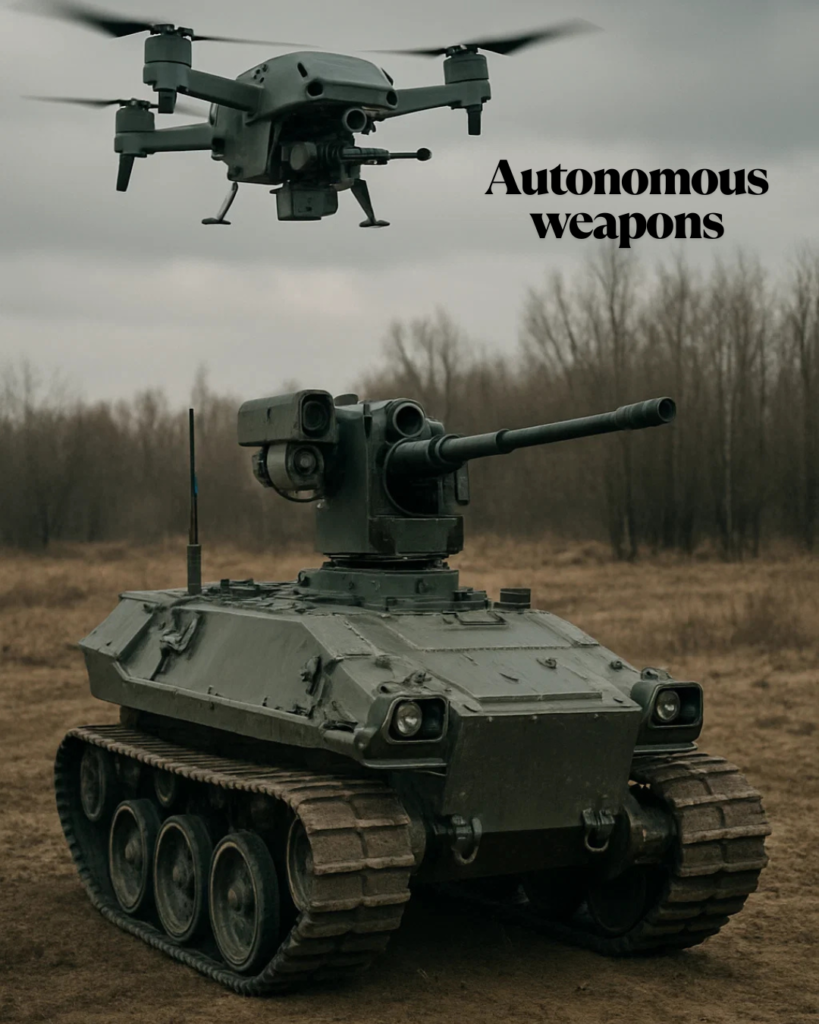Table of Contents
ToggleCan you think of the world where machine will decide who live or who die?. It look weird and alarming but it the reality that is going to happen. Autonomous weapons—these are AI-powered machines that can find and attack targets without the human interaction.
Can we really trust a machine to make decisions about who lives and who die? What if the AI makes a mistake? And if something goes wrong, who should be responsible for that? In this blog post, we’ll take a closer look at autonomous weapons—how they work, the benefits they offer, the risks they bring, and the tough ethical questions we all need to think about.
What are Autonomous weapons?
Autonomous weapons are smart military machines that can find, follow, and attack targets all by themselves using artificial intelligence (AI). Unlike regular drones that need a person to control them from a distance, these weapons make their own decisions without any human help.
Types of Autonomous weapons
- Drones: Unmanned aerial vehicles (UAVs) made with AI to carry out surveillance or strikes.
- Robotic tanks: Ground-based vehicles that can navigate terrain and engage targets autonomously.
- Naval systems: AI-powered submarines and ships designed for underwater or surface warfare.

Current use cases of Autonomous weapons
Today, many countries are actually building and use autonomous weapons in real life. These are weapons that use artificial intelligence (AI) to make decisions with little or no help from humans. Below are five real-life examples that show how AI is becoming a big part of modern warfare:
U.S. Navy’s Sea Hunter (Autonomous Ship)
The Sea Hunter is an autonomous unmanned surface vehicle (USV) developed by the U.S. Defense Advanced Research Projects Agency (DARPA). It is designed for anti-submarine warfare and can operate for months at sea without a crew.
How it works:
The Sea Hunter uses AI to navigate, avoid collisions, and track enemy submarines. It can operate autonomously or be remotely controlled.
Deployment:
The U.S. Navy has been testing a Sea Hunter since 2016. It’s an unmanned (no crew onboard) vessel designed to help with spying and gathering information. The Navy plans to add it to their fleet to support missions like watching over large ocean areas and collecting important data.
Ethical concerns:
The use of self-driving (autonomous) ships in war brings up serious concerns. One big worry is that these ships could cause fights to get worse quickly, especially if they make decisions on their own without any military officer. When there’s no human in control, there’s a risk that a small mistake or misunderstanding could lead to bigger problems, like conflict or harm. People are also concerned about who is responsible if something goes wrong. Without human oversight, it’s hard to make sure these powerful machines are used wisely and safely.
3. Russia’s Uran-9 (Combat Robot)
The Uran-9 is a Russian unmanned ground vehicle (UGV) build with a 30mm cannon, machine guns, and anti-tank missiles. It’s designed for reconnaissance and combat missions in urban environments.
How it works:
The Uran-9 can be remotely operated or function semi-autonomously, using AI to navigate and engage targets.
Deployment:
Russia has reportedly tested the Uran-9 in Syria, where it was used for surveillance and combat support. However, its performance was criticized for technical glitches and limitations.
Ethical concerns:
The Uran-9’s semi-autonomous capabilities highlight the risks of relying on AI in complex, that can lead to unpredictable combat scenarios.
4. Turkey’s Kargu-2 (Kamikaze Drone)
The Kargu-2, developed by Turkish defense company STM, is a small, rotary-wing drone designed for swarm attacks. It’s equipped with explosives and can autonomously identify and attack targets.
How it works:
The Kargu-2 uses AI and machine learning to identify targets based on pre-programmed criteria. It can operate in swarms, overwhelming enemy defenses.
Deployment:
The Kargu-2 was reportedly used in Libya in 2020, where it autonomously attacked human targets, marking one of the first documented uses of AI-powered lethal autonomous weapons in combat.
Ethical concerns:
The use of swarming drones raises security alarms about the potential for indiscriminate attacks and the difficulty of controlling autonomous systems in dynamic environments.
5. China’s Sharp Claw (Unmanned ground vehicle)
The Sharp Claw is a Chinese unmanned ground vehicle (UGV) designed for reconnaissance and combat. It’s equipped with a machine gun and can operate autonomously or be remotely controlled.
How it works:
The Sharp Claw uses AI to navigate terrain, avoid obstacles, and engage targets. It’s designed to support infantry units in combat.
Deployment:
China has showcased the Sharp Claw in military exercises, highlighting its capabilities in urban warfare and counter-terrorism operations.
Ethical concerns:
The deployment of UGVs like the Sharp Claw raises ethical concerns about the potential for misuse in civilian areas and the lack of international regulations governing their use.
The rise of AI in warfare
AI is transforming the battlefield and autonomous weapons are at the forefront of this shift. Here’s why:
Why to use Autonomous weapons?
- Reduced risk to human soldiers: Machines can go where humans can’t, which can save human lives.
- Faster decision making: AI can process data and make decisions in milliseconds, far faster than any human.
- Cost efficiency: Autonomous systems can operate around the clock without fatigue, reducing long-term costs.
Global Adoption
Countries like the U.S., China, and Russia are investing heavily in autonomous weapons, by seeing them the rest of the world can also think of it. But as these technologies advance, so do the ethical and practical challenges.
Ethical concerns surrounding Autonomous Weapons
The use of autonomous weapons raises serious ethical questions. Here are the key concerns:
1. Lack of human judgment
Machines don’t have morals or empathy. They follow algorithms, not ethical principles. This raises the question: Can we trust AI to make life-and-death decisions?
Example: An autonomous weapon might misidentify a civilian as a combatant, which can lead to serious harm.
2. Accountability
If an autonomous weapon makes a mistake, who is to be blame? The programmer? The military commander? The AI itself?
Example: Legal systems aren’t equipped to handle cases where machines, not humans, are responsible for harm.
3. Escalation of conflict
Autonomous weapons could lower the threshold for going to war. If machines are doing the fighting, will leaders be more willing to engage in conflict?
Example: The risk of rapid, uncontrolled escalation in conflicts involving autonomous systems.
4. Bias and errors
AI systems are only as good as the data they’re trained on. If the data is biased or flawed, the AI will be too.
Example: A biased algorithm might disproportionately target certain groups, exacerbating existing inequalities.
Can AI make life and death decisions?
As artificial intelligence (AI) becomes more advanced, its role in warfare is growing fast. One of the most serious and controversial questions is: Should AI be allowed to make life and death decisions on the battlefield?
In recent years, some countries like U.S., China, and Russia have started developing autonomous weapons—military machines like drones, robots, or missiles that can identify and attack targets without human control. These systems use AI to analyze data, track movements, and decide when to fire.
The goal is to make combat faster and more precise, while reducing risk to soldiers. But when a machine decides who lives and who dies, it raises big ethical concerns.
Many experts and organizations worry about the risks of removing humans from the decision-making loop. Unlike a human soldier, AI doesn’t have empathy or moral judgment. Mistakes in the code or biased data could lead to wrongful deaths or attacks on civilians.
There’s also the fear that if multiple countries rely on AI weapons, conflicts could escalate quickly and become harder to control.
Key concerns include:
- Lack of accountability – Who is responsible if the AI makes a deadly mistake?
- Bias in targeting – AI can reflect human or data bias, leading to unfair targeting.
- Moral questions – Should machines ever have the power to decide human fate?
- Global security risks – Autonomous weapons could trigger unintended wars.
Because of these issues, many experts call for international rules to limit or ban fully autonomous weapons. The question is not just about the technology, it is about the future of warfare and what role humanity should play in it.
Conclusion:
You can understand now that autonomous weapon offer significant advantages, like reducing human casualties and improving efficiency, they also pose serious ethical and practical challenges.
The question is not whether we can build autonomous weapons, instead it should be made or not. As AI continues to advance, the decisions we make today will shape the future of warfare and, ultimately, the future of humanity.
What do you think about autonomous weapons? Should AI be allowed to make life-and-death decisions? Share your thoughts in the comments below—we’d love to hear from you!
Visit my website THE SYNTELLIX , for more info about AI ETHICS.
People also ask
What are the ethical dilemmas of autonomous vehicles?
Autonomous vehicles raise ethical dilemmas around life-and-death decision-making, such as how a self-driving car should react in an unavoidable crash scenario—protect the passenger or pedestrians? Other concerns include data privacy, liability in accidents, and bias in training data that could affect how the car responds to different populations or environments.
What are the ethical challenges of autonomous systems?
Autonomous systems, including robots and AI-powered machines, face ethical challenges like accountability, lack of transparency, and value alignment—ensuring machines act in ways that reflect human values. There’s also concern about job displacement, military use of AI, and over-reliance on machines in critical tasks without adequate human oversight.
What is the ethical dilemma of autonomy?
The ethical dilemma of autonomy revolves around the balance between machine independence and human control. While autonomy allows systems to operate without direct input, it raises questions like: Who is responsible if the machine causes harm? Can autonomous systems make morally informed decisions? And how do we ensure they do not override human authority or ethics?
What is the ethical dilemma we face on AI and autonomous technology?
The central dilemma is trust vs. control. As AI becomes more autonomous, we face issues around decision-making authority, transparency, and bias. Should we allow machines to make decisions with life-altering consequences? Can they be trusted to make fair and ethical choices? Balancing innovation with safety, fairness, and accountability remains a major challenge.
Stay ahead of the curve with the latest insights, tips, and trends in AI, technology, and innovation.

